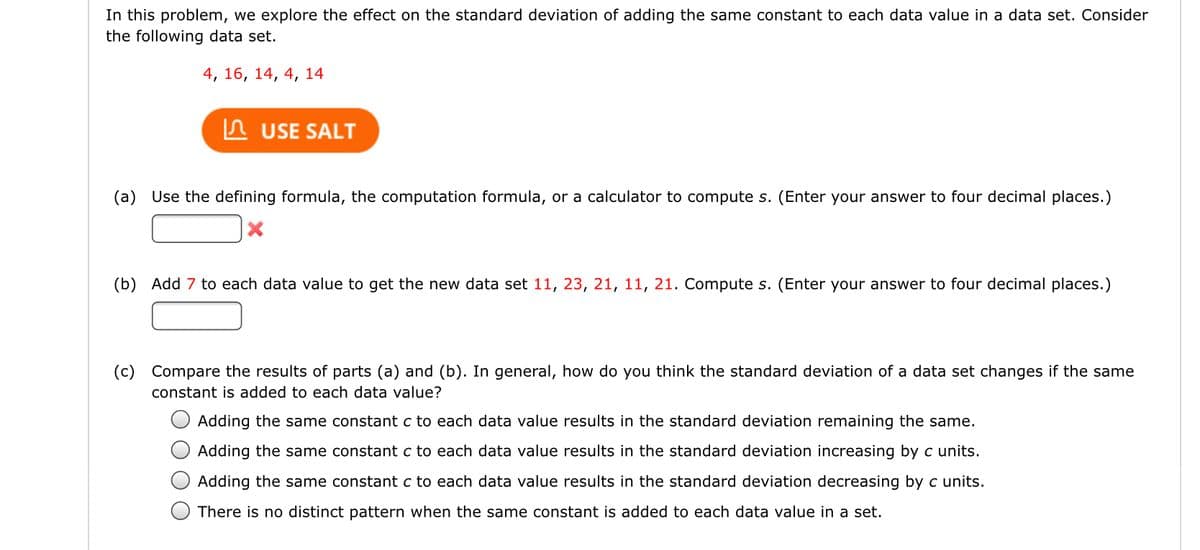the following data set. 4, 16, 14, 4, 14 n USE SALT (a) Use the defining formula, the computation formula, or a calculator to compute s. (Enter your answer to four decimal places.) (b) Add 7 to each data value to get the new data set 11, 23, 21, 11, 21. Compute s. (Enter your answer to four decimal places.) (c) Compare the results of parts (a) and (b). In general, how do you think the standard deviation of a data set changes if the same constant is added to each data value? O Adding the same constant c to each data value results in the standard deviation remaining the same. O Adding the same constant c to each data value results in the standard deviation increasing by c units. Adding the same constant c to each data value results in the standard eviation decreasing by c units. O There is no distinct pattern when the same constant is added to each data value in a set.
the following data set. 4, 16, 14, 4, 14 n USE SALT (a) Use the defining formula, the computation formula, or a calculator to compute s. (Enter your answer to four decimal places.) (b) Add 7 to each data value to get the new data set 11, 23, 21, 11, 21. Compute s. (Enter your answer to four decimal places.) (c) Compare the results of parts (a) and (b). In general, how do you think the standard deviation of a data set changes if the same constant is added to each data value? O Adding the same constant c to each data value results in the standard deviation remaining the same. O Adding the same constant c to each data value results in the standard deviation increasing by c units. Adding the same constant c to each data value results in the standard eviation decreasing by c units. O There is no distinct pattern when the same constant is added to each data value in a set.
Glencoe Algebra 1, Student Edition, 9780079039897, 0079039898, 2018
18th Edition
ISBN:9780079039897
Author:Carter
Publisher:Carter
Chapter10: Statistics
Section10.4: Distributions Of Data
Problem 19PFA
Related questions
Question

Transcribed Image Text:In this problem, we explore the effect on the standard deviation of adding the same constant to each data value in a data set. Consider
the following data set.
4, 16, 14, 4, 14
n USE SALT
(a) Use the defining formula, the computation formula, or a calculator to compute s. (Enter your answer to four decimal places.)
(b) Add 7 to each data value to get the new data set 11, 23, 21, 11, 21. Compute s. (Enter your answer to four decimal places.)
(c)
Compare the results of parts (a) and (b). In general, how do you think the standard deviation of a data set changes if the same
constant is added to each data value?
Adding the same constant c to each data value results in the standard deviation remaining the same.
Adding the same constant c to each data value results in the standard deviation increasing by c units.
Adding the same constant c to each data value results in the standard deviation decreasing by c units.
There is no distinct pattern when the same constant is added to each data value in a set.
Expert Solution
This question has been solved!
Explore an expertly crafted, step-by-step solution for a thorough understanding of key concepts.
This is a popular solution!
Trending now
This is a popular solution!
Step by step
Solved in 5 steps with 2 images

Recommended textbooks for you

Glencoe Algebra 1, Student Edition, 9780079039897…
Algebra
ISBN:
9780079039897
Author:
Carter
Publisher:
McGraw Hill

Glencoe Algebra 1, Student Edition, 9780079039897…
Algebra
ISBN:
9780079039897
Author:
Carter
Publisher:
McGraw Hill